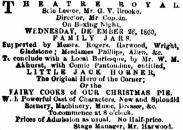 8791454989921826693.jpg
8791454989921826693.jpg
 8791454989921826693.jpg
8791454989921826693.jpg
The topical jokes and characters refer to such topicalities as the 'recent political changes, the composition of the cabinet, the loquacity of our legislators, the irregularities of the telegraphic system, the contemplated formation of street railways, the progress of exploration. Australian-servant-galism [etc].' The plot is described in the Argus as involving the triumph of Fairy Progressa by the 'introduction into the curriculum of instruction in applied sciences, and other subjects until recently regarded as heterodox by those presiding over the old seats of learning' (p.4).
The Argus records that a number of business establishments in the city found their place among the scenes in the harlequinade. Notable were the Cremorne (featuring its rotunda), Coppin's XXX, and the Collingwood Gas Company (27 Dec. 1860, p.5). Bell's Life in Victoria also mentions the Melbourne terminus of the St Kilda railway, the Monster Clothing Mart, and the exterior of Harry Jenkins' place (29 Dec. 1860, p.2).
Akhurst possibly adapted his version from E. L. Blanchard's Little Jack Horner (1857).
 Harlequin Little Jack Horner ; Or, The Christmas Pie and the Fairies
Harlequin Little Jack Horner; or, The Christmas Pie, and the Fairies of the Silver Ferns
1868
Z850592
1868
single work
musical theatre
pantomime
fantasy
Harlequin Little Jack Horner ; Or, The Christmas Pie and the Fairies
Harlequin Little Jack Horner; or, The Christmas Pie, and the Fairies of the Silver Ferns
1868
Z850592
1868
single work
musical theatre
pantomime
fantasy
The Sydney Morning Herald notes that while this pantomime was an adaptation of W. M. Akhurst's Little Jack Horner: The Original Hero of the Corner (1860), it had been 'almost entirely changed to suit present topics of interest in Sydney, and these are introduced with a droll piquancy and unflagging humour that are sustained throughout the pantomime' (25 December 1868, p.4). A critic writing for Bell's Life in Sydney similarly notes:
'The witty and telling dialogue of the opening is being continually enriched by new local 'hits' which form no inconsiderable feature in the attractiveness of the piece. Among these may be specially mentioned a new parody on Billy Barlow, written by Mr W. Cooper, and excellently well rendered by Mr Stuart O'Brien' (9 January 1869, p.3).
The paper reports the following week that 'Continual novelties are being produced in the comic scenes, and the local allusions in the opening are frequently changed and brought up to date, so that each performance, to some extent differs from its predecessor' (16 January 1869, p.3).
The pantomime begins with a grand ballet in the Dell of Silver Ferns, after which the fairies Progressa and Retrogressa argue as to who has the most influence over Little Jack Horner. The scene switches to Jack's cottage, where he is seen studiously learning his letters so that he might court Myozoe. His new determination is a result of having his previous attempt coolly received by the young lady due to his lack of learning. Pleased with his efforts, Fairy Progressa promises to give him poetic fire, and his new-found learning is demonstrated in the songs 'The Grenadier' and 'Hickory Dickory Dock'. Later, while continuing his learning, a pie is brought in, and he proceeds to describe to Old Proverbs the ideas represented in the plums, each of which has a political significance. Old Proverbs declines a slice of pie and advises Jack that knowledge is power. He then presents him with the Sword of Perseverance (which enables a scene in which Jack parodies the sword song from the Grand Duchess of Gerolstein).
One of the highlights of the production is said to have revolved around Alphabet Castle and an army of juvenile soldiers led by 'Commanders' Blanch and Master Albert Leopold. Other songs incorporated into the pantomime included 'La Donna e Mobile' (sung by Jack), 'She's No Pal of Mine' (Fairy Progressa and Fairy Retrogressa), 'John Robertson my jo John' [sic] (Jack's mother), and 'Little Jack Horner Sat in the Corner' (chorus).
1860: Theatre Royal, Melbourne, 26 December 1860 - 19 January 1861
1861: Lyceum Theatre, Bendigo (Victoria) ; 4 February.
This entry has been sourced from research undertaken by Dr Clay Djubal into Australian-written popular music theatre (ca. 1850-1930). See also the Australian Variety Theatre Archive
Details have also been derived in part from the Annotated Calendar of Plays Premiered in Australia: 1850-1869.